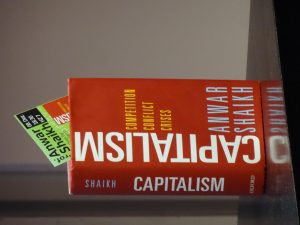The Lehman 10th Anniversary spin as a Teachable Moment
✑ MICHAEL HUDSON | ± 14 minutes
‟The $4.3 trillion that could have been used to save debtors was given to the banks and Wall Street firms.
Wall Street did not let the Lehman Brothers crisis go to waste. The banks that have paid the largest fines for financial fraud are now much bigger and more profitable. The victims of their junk mortgage loans are poorer, and the economy is facing debt deflation.
Originally published by Michael Hudson (Sept. 17, 2018). Explanatory boxes by SE.
|
|---|
About the author (click)
Prof. Michael Hudson is a veteran of Wall Street, Distinguished Research Professor of Economics at the University of Missouri at Kansas City (UMKC) and author of J is for Junk Economics (2017), Killing the Host (2015), The Bubble and Beyond (2012) and many others. Visit his personal website for a rich collection of his many books, articles, speeches and interviews.
Today’s financial malaise for pension funds, state and local budgets and underemployment is largely a result of the 2008 bailout, not the crash. What was saved was not only the banks – or more to the point, as Sheila Bair pointed out, their bondholders – but the financial overhead that continues to burden today’s economy.
Sheila Bair? (click)
Sheila Colleen Bair was the Chair of the U.S. Federal Deposit Insurance Corporation (FDIC) from 2006 to 2011, a government corporation providing deposit insurance to depositors in U.S. commercial banks and savings institutions. She was critical of the bailout programs of the FED and told journalist Joe Nocera:
"Why did we do the bailouts? It was all about the bondholders. They did not want to impose losses on bondholders, and we did. We kept saying: 'There is no insurance premium on bondholders,' you know? For the little guy on Main Street who has bank deposits, we charge the banks a premium for that, and it gets passed on to the customer. We don't have the same thing for bondholders. They're supposed to take losses."
Debt deflation? (click)
Michael Hudson explains debt deflation in an interview by Bonnie Falkner (2011):
Could you explain debt deflation? It’s a confusing term.
Economics textbooks depict people earning income and spending it on the goods and services they produce. This is why Henry Ford said he paid his workers $5.00 a day – so that they could buy the Fords they made. Economists call this circular flow Say’s Law.
But people spend a rising proportion of their income to pay debt service. That is their first charge. Before they decide how much is available to spend on goods and services, they have to pay their credit card debt, student loans, other bank debt, and of course the mortgage. The more they pay the banks, the less they have to spend on goods and services. Business sales shrink, because the banks recycle their interest receipts into even more loans – on even “easier” terms, meaning more debt leveraging. So the “real” economy of production and consumption shrinks while the payments to the financial sector go up.
Financial investors don’t buy many goods and services. They leave their revenue in the financial system, mainly to be lent out on new loans, sent abroad or used for speculation. Debt deflation is what happens when spending is diverted away from buying goods and services to paying debts. The financial sector grows, relative to the “real” production-and-consumption economy. So debt deflation of the underlying economy goes hand in hand with asset-price inflation fueled by increasingly loose credit and steeper debt leveraging.
I see. And then that deflates the economy.
Yes. Less national income is available to be spent on goods and services, and more is given to the financial sector.
Economics textbooks depict people earning income and spending it on the goods and services they produce. This is why Henry Ford said he paid his workers $5.00 a day – so that they could buy the Fords they made. Economists call this circular flow Say’s Law.
But people spend a rising proportion of their income to pay debt service. That is their first charge. Before they decide how much is available to spend on goods and services, they have to pay their credit card debt, student loans, other bank debt, and of course the mortgage. The more they pay the banks, the less they have to spend on goods and services. Business sales shrink, because the banks recycle their interest receipts into even more loans – on even “easier” terms, meaning more debt leveraging. So the “real” economy of production and consumption shrinks while the payments to the financial sector go up.
Financial investors don’t buy many goods and services. They leave their revenue in the financial system, mainly to be lent out on new loans, sent abroad or used for speculation. Debt deflation is what happens when spending is diverted away from buying goods and services to paying debts. The financial sector grows, relative to the “real” production-and-consumption economy. So debt deflation of the underlying economy goes hand in hand with asset-price inflation fueled by increasingly loose credit and steeper debt leveraging.
I see. And then that deflates the economy.
Yes. Less national income is available to be spent on goods and services, and more is given to the financial sector.
Quantitative Easing (QE)? (click)
Michael Hudson explains Quantitative Easing in his book J is for Junk Economics (2017) (extract from Nick Johnson):
Quantitative Easing: Central bank support for bank credit creation to drive down interest rates and re-inflate real estate and stock market prices. In the wake of the 2008 crash the Federal Reserve and the European Central Bank (ECB) promoted new bank lending and arbitrage speculation as an alternative to writing down debts. The hope was that new bank lending would re-inflate the bubble. The ECB’s QE (“as much as it takes,” said its president, Mario Draghi) lent money and purchased bonds to bail out banks and bondholders for their bad loans and investments. But it did not create money to revive businesses or indebted homeowners or consumers. Focusing only on subsidizing bank balance sheets, its aim was to save the financial sector and the One Percent behind it, not the economy. So QE had little effect in coping with the underlying problem, which was debt deflation. In fact, Eurozone governments imposed austerity, sacrificing national economies by giving priority to creditor claims.
In the United States, the Federal Reserve accepted mortgages and other bank loans at full face value as reserve deposits, enabling banks to meet their capital ratios and create new electronic credit. But the $4.2 trillion US Federal Reserve creation of bank reserves did not increase commodity prices or wages as the Quantity Theory of Money implied it would. Banks engaged mainly in speculation. They bought foreign bonds and currencies, and lent to hedge funds and for corporate share buybacks, mergers and acquisitions. None of this financed new investment. The US and European economies remained debt-wracked and suffering deepening debt deflation.
Without QE the banks would have had to sell their loans in “the market” at falling prices, at rising interest rates – further lowering the price of collateral-backed bank loans, forcing yet further sell-offs. So in the name of saving “the market”, the Fed and ECB overruled it in the aftermath of the 2008 junk mortgage crash.
In the United States, the Federal Reserve accepted mortgages and other bank loans at full face value as reserve deposits, enabling banks to meet their capital ratios and create new electronic credit. But the $4.2 trillion US Federal Reserve creation of bank reserves did not increase commodity prices or wages as the Quantity Theory of Money implied it would. Banks engaged mainly in speculation. They bought foreign bonds and currencies, and lent to hedge funds and for corporate share buybacks, mergers and acquisitions. None of this financed new investment. The US and European economies remained debt-wracked and suffering deepening debt deflation.
Without QE the banks would have had to sell their loans in “the market” at falling prices, at rising interest rates – further lowering the price of collateral-backed bank loans, forcing yet further sell-offs. So in the name of saving “the market”, the Fed and ECB overruled it in the aftermath of the 2008 junk mortgage crash.
 |
| Ben Bernanke, Chairman of the FED from 2006 to 2014 (Wikimedia) and figures of bank bailouts (CNN) |
The higher the debt/income ratio rises, the more interest, amortization payments and late fees are extracted from the economy. The resulting debt burden slows the economy, causing defaults. That is what happened in 2008, and is accelerating today as debt ratios are rising for corporate debt, state and local debt, and student debt.
Neither legislators, academics nor the public at large recognize a corollary Second Principle following from the first: An over-indebted economy cannot be saved unless the banks fail. That means writing down the financial claims by the One to Ten Percent – in other words, the net debts owed by the 99 to 90 Percent. Wiping out bad debts involves writing down the “bad savings” that are the counterpart to these debts on the asset side of the balance sheet. Otherwise the economy will suffer debt deflation and austerity.
‟An over-indebted economy cannot be saved unless the banks fail. That means writing down the financial claims by the One to Ten Percent – in other words, the net debts owed by the 99 to 90 Percent.“Recovery” since 2008 has been much slower than earlier recoveries because debt deflation is siphoning off more and more personal and corporate income. To make matters worse, the bailout’s policy of Quantitative Easing to re-inflate asset prices has reduced rates of return for pension funds, insurance companies and employee retirement savings. This means that more state and local government income must be diverted to meet retirement commitments.
Something has to give, and it is not likely to be the savings of the donor class at the top of the economic pyramid. As a result, the economy at large is threatened with an exponentially expanding erosion of disposable income and net worth for most people and companies. Investment managers are warning of a financial meltdown, given today’s historically high price/earnings ratios for stocks and also for rental properties.
Price/earnings ratios? (click)
The price-earnings ratio (P/E ratio) is the "ratio for valuing a company" and "can be calculated as: Market Value per Share / Earnings per Share", Investopedia explains (including a short explanatory video). "In essence, the price-earnings ratio indicates the dollar amount an investor can expect to invest in a company in order to receive one dollar of that company’s earnings. [...] In general, a high P/E suggests that investors are expecting higher earnings growth in the future compared to companies with a lower P/E."
The P/E ratio "is higher today than it was at any point in a history that begins in 1881 except for the climax of the late-1990s bubble", economist Doug Henwood showed in an article from February 2018, also published on Socialist Economist. "It was lower in 1929 than it is today." Henwood's graph:

The P/E ratio "is higher today than it was at any point in a history that begins in 1881 except for the climax of the late-1990s bubble", economist Doug Henwood showed in an article from February 2018, also published on Socialist Economist. "It was lower in 1929 than it is today." Henwood's graph:

None of this was spelled out in the September 15 weekend marking the tenth anniversary of Lehman Brothers’ failure and subsequent rescue of Wall Street. President Obama, Treasury Secretary Tim Geithner and their fellow financial lobbyists at the Federal Reserve and Justice Department are credited with saving “the economy,” as if their donor class on Wall Street was a good proxy for the economy at large. “Saving the economy from a meltdown” has become the euphemism for saving bondholders and other members of the One Percent from taking losses on their bad loans. The “rescue” is Orwellian doublespeak for expropriating over nine million indebted Americans from their homes, while leaving surviving homeowners saddled with enormous bubble-mortgage payments to the FIRE sector’s owners.
FIRE? (click)
From Michael Hudson's The Insider's Economic Dictionary:
"FIRE sector: An acronym for Finance, Insurance and Real Estate, combined in the national income accounts to reflect the symbiosis between these sectors. See Rentier.
[...]
Rentier: Someone living on a fixed income, such as the French rentes, government bonds. What Keynes called a “functionless investor” in his recommendation for “euthanasia of the rentier” (General Theory, p. 376 1961 Papermacs edition, MacMillan & Company). Property rents and interest are the two major modern forms of rentier income. (See Adam Smith, Economic Rent and FIRE Sector.)"
[...]
Rentier: Someone living on a fixed income, such as the French rentes, government bonds. What Keynes called a “functionless investor” in his recommendation for “euthanasia of the rentier” (General Theory, p. 376 1961 Papermacs edition, MacMillan & Company). Property rents and interest are the two major modern forms of rentier income. (See Adam Smith, Economic Rent and FIRE Sector.)"
NINJA? (click)
From Investopedia:
"A NINJA loan is a slang term for a loan extended to a borrower with "no income, no job and no assets." Whereas most lenders require the borrower to show a stable stream of income or sufficient collateral, a NINJA loan ignores the verification process. [...] NINJA loans are a type of loan that bases the credit approval decision on a borrower’s credit score with no consideration for income or assets. These types of loans were more common prior to the 2008 financial crisis. After the 2008 financial crisis, regulations were implemented to improve standard lending practices across the credit market.
Cash for trash? (click)
From Marxism and the Global Financial Crisis (Hilel Ticktin, 2013), footnote 34 on page 86:
'Mark to model', from Investopedia:
"Since September 2008, the US Federal Reserve has engaged in 'cash for trash' swaps, accepting junk mortgages at their nominal 'mark to model' values. The Treasury has printed bonds for their these swaps, and taken Fannie Mae and Freddy Mac onto its own balance sheet, giving public guarantees that 'taxpayers' will make good on all losses'"
'Mark to model', from Investopedia:
"Mark-to-model is a pricing method for a specific investment position or portfolio based on internal assumptions or financial models. This contrasts with traditional mark-to-market valuations, in which market prices are used to calculate values as well as the losses or gains on positions. Assets that must be marked-to-model either don't have a regular market that provides accurate pricing, or valuations rely on a complex set of reference variables and timeframes. This creates a situation in which guesswork and assumptions must be used to assign value to an asset."
Among Democrats, the most extreme tunnel vision denying that debt is a problem comes from Paul Krugman: Writing that “The purely financial aspect of the crisis was basically over by the summer of 2009,” he criticized what he called the “bizarre Beltway consensus that despite high unemployment and record low interest rates, debt, not jobs, was the real problem.”1
This misses the point that 2009 was the real beginning for most of the nine million homeowners being foreclosed on and evicted from their homes. Consumers found themselves with less income “freely disposable” after paying their monthly FIRE sector nut off the top of their paycheck – housing charges, credit card charges, medical insurance, student debt, FICA withholding and tax withholding. Krugman says that he would have solved the problem by more deficit spending to pump enough money into the economy to enable debtors to keep paying the banks their exponential growth of interest claims.
FICA? (click)
FICA is a tax to fund Social Security and public health care (Medicare). From Investopedia:
"The Federal Insurance Contributions Act (FICA) is a U.S. law that creates a payroll tax requiring a deduction from the paychecks of employees as well as a contribution from employers to fund the Social Security and Medicare programs. Why did we do the bailouts? It was all about the bondholders. They did not want to impose losses on bondholders, and we did. We kept saying: 'There is no insurance premium on bondholders,' you know? For the little guy on Main Street who has bank deposits, we charge the banks a premium for that, and it gets passed on to the customer. We don't have the same thing for bondholders. They're supposed to take losses."
At the neoliberal/neocon Brookings Institution, Treasury secretaries Hank Paulson and Tim Geithner joined with the Federal Reserve’s Ben Bernanke to explain that the public simply didn’t understand how successful they all were in saving not only the banks, but non-bank financial institutions. Unlike Sheila Bair, they did not point out that behind these institutions were the bondholders, the One Percent of savers who held the rest of the economy in debt. Bernanke wrote a Financial Times piece producing junk statistics purporting to show that there was no underlying debt or financial problem at all, merely a “panic.”3 To paraphrase, he said: “The crisis was all in the mind folks. Nothing to see here. Keep moving on.” It is as if, as Margaret Thatcher liked to insist, There Is No Alternative.
Can this bailout without debt writedowns really bring prosperity? Can economies achieve growth by “borrowing their way out of debt,” by creating enough new credit to cover the interest charges out of capital gains from the asset-price inflation fueled by new bank credit. That is the logic that has guided the Federal Reserve’s net $4.3 trillion in Quantitative Easing, and the parallel credit creation by the European Central Bank under Mario “Whatever it takes” Draghi. Ellen Brown recently published a review, “Central Banks Have Gone Rogue, Putting Us All at Risk”, noting that the ECB has become a major stock buyer.4 The beneficiaries are the stockholders who are concentrated in the wealthiest percentiles of the population. Governments are not underwriting homeownership or the solvency of labor’s pension plans, but are underwriting the value of collateral backing the savings of the narrow financial class.
‟What is celebrated as growth of the GDP since 2008 has been mainly the growth in financial extraction.The GDP accounts report the widening gap between low government bond rates and the cost of credit to banks compared to the higher rates paid by mortgage borrowers, credit-card holders and student loan customers as “financial services.” What is extracted from the economy is added to the GDP statistic instead of being treated as a subtrahend. This absurd practice reflects the degree to which Wall Street lobbyists have captured economic statistics. The National Income and Product Accounts (NIPA) have been turned into a vehicle for deception. What is celebrated as growth of the GDP since 2008 has been mainly the growth in financial extraction, along with the health-insurance sector profiting from Obamacare.
Glenn Hubbard, chairman of the Council of Economic Advisors under George W. Bush, uses Orwellian doublethink to pretend that “Debt is Wealth.” He concludes a Wall Street Journal op-ed: “An ability to recapitalize banks remains crucial and must be explained to a skeptical Congress and public,”5 so that wealthy bondholders and speculators will not suffer losses.
On a brighter side, Adair Turner pokes fun at the “Authoritative experts such as the IMF [who] explained how increased securitisation and trading activity made the financial system more efficient and less risky.”6 It was as if “options” and hedges can get rid of risk entirely, not shift them onto Wall Street victims such as the naïve German Landesbanks.
The aim of this week’s disinformation campaign is to prevent popular anger advocating what was done in classical antiquity. The ancients fought civil wars for land redistribution and debt cancellation. Today the demand should be for mortgage writedowns to bring their carrying charges in line with reasonable rent charges, limited to the former normal 25 percent of homeowner income – while rolling back the FICA wage withholding and allied taxes levied to bail out the creditor class.
An Athenian antecedent to today’s financial takeover
It is an old story, with a striking parallel in classical Athens. After losing the Peloponnesian war to oligarchic Sparta in 404, a Pinochet-style military junta – the Thirty Tyrants – were installed. During its eight months of terror, its’ members killed a reported 1,500 democratic advocates whose land and other property they grabbed. Advocates of democracy took refuge in Thrace and other neighboring regions.
After the exiled democratic leaders reconquered Athens, they sought to restore harmony, going so far as to pay off all the debts that the oligarchic junta had run up to Sparta. To top matters, the subsequent 4th century obliged Athenian jurors and indeed, mayors in some Greek cities to swear an oath: “I will not allow private debts (chreon idiom) to be cancelled, nor lands nor houses of Athenian citizens to be redistributed.”7
If no such pledge is needed today by public officials, it is because the financial administrators at the Treasury, Federal Reserve and other regulatory agencies already have shown themselves to be so tunnel-visioned from graduate school through their employment history that they can be trusted to find debt writedowns as unthinkable as enforcing laws against criminal financial fraud to punish individuals rather than their institutions. Academia joins in the deception that financial engineering can sustain a geometric growth in debt ad infinitum without imposing austerity. The bailout aftermath has demonstrated that corporations are not really “persons” if they cannot be given jail time.
The key financial principle is that this self-expansion of interest-bearing debt grows to absorb more and more of the economic surplus. The solution therefore must involve wiping out the excess debt – and savings that have been badly lent. That is what crashes are supposed to do. It was not done in 2008. That is why the status quo was not restored. A vast giveaway to the financial elites occurred, setting the rest of the economy on a road to debt peonage.
It would have been nice to have read an article by Sheila Bair explaining the procedures that the FDIC had in place, ready to take over insolvent Citigroup and other banks in similar straits, saving all the insured depositors by taking over these institutions. No doubt as public institutions they would not have indulged in junk mortgages or, for that matter, takeover loans.
It would have been nice to hear from Hank Paulson and perhaps Barney Frank on how they tried to get incoming President Obama to write down bad mortgages whose carrying charges were as far above the debtor’s ability to pay as they were above the going rental value for similar properties. It would have been nice to hear a mea culpa from Mr. Obama apologizing for representing the interest of his campaign donors by standing between them and his voters with pitchforks. Even an article by Tim Geithner or Eric Holder on how lucky they felt at getting such high-paying jobs after they left office from the financial sector they had overseen and “regulated.”
What is needed now is to follow up the primary policy perception that today’s financially dysfunctional economy cannot be saved without a bank crash. That means rolling back the enormous gains that the FIRE sector has made since 1980 at the expense of the “real” economy. Banks have ceased to be an “engine of growth.” They are not making loans to create new means of production. They are lending to asset strippers, not asset creators. It is not hard to show this statistically. (I drafted an attempt in Killing the Host, and am now working with Democracy Collaborative to prepare a larger study.)
At stake is whether the U.S. and Western European economies are going to end up looking like those of Greece, Latvia and Argentina – or imperial Rome for that matter. Neoliberals applaud today’s victorious finance capitalism as the “end of history.” One such end has already occurred, at the close of Roman antiquity. It is remembered as the Dark Age. Progress stopped as the creditor and landowning class lorded it over the rest of society. Trade survived only among the lords at the top of the economic pyramid. Today’s “End of History” dream threatens to unfold along similar lines. It is all about relative power of the One Percent.
NOTES
1 Paul Krugman, “Days of Fear, Years of Obstruction,” The New York Times, September 14, 2018.
2 John Cassidy, A World of Woes: A global take on a decade of financial crisis,” The New Yorker, September 17, 2018.
3 “Ben Bernanke pins blame for Great Recession on bank panic,” Financial Times, September 13, 2018.
4 Ellen Brown recently published a review, Central Banks Have Gone Rogue, Putting Us All at Risk.” Public Banking Institute and Truthdig, September 13, 2018.
5 Glenn Hubbard, “Bailouts Shouldn’t Be Only for Banks” Wall Street Journal, September 14, 2018. To be sure, Hubbard acknowledges that Republicans had agreed to but incoming President Obama nixed: “The government should have directed a mass refinancing of mortgages for primary homes in which the borrower was current in payments.”
6 Adair Turner, “Banks are safer but debt remains a danger,” Financial Times, September 12, 2018.
7 Demosthenes Against Timocrates (xxiv.149)
























Comments
Post a Comment
Your thoughts...